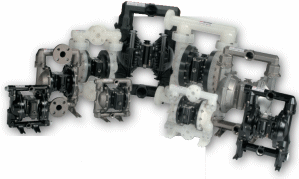
Contact Details:
Liquid Movers
1024 Schooner Street
1024 Schooner Street
Laser Park
Honeydew
Gauteng
2040
South Africa
Tel: +27 (0)11 708 0600
Alt. Tel: +27 (0)31 701 5933
Fax: +27 (0)21 981 9123
Send Enquiry | Company Information

In a recent survey of CHEM.INFO Magazine "10 New Technologies you Shouldn't Miss".
Product News Tuesday, October 28, 2008: Liquid Movers
In a recent survey, we asked readers what they most want to find in the pages of CHEM.INFO magazine. INNOVATION was the top response. In fact, it was the most popular and passionate request.
Reliable Diaphragm Pumps With Special Valves & Seals
Design flaws in pumps can cause the loss of production and many headaches for plant managers. Poor performance is exhibited in a variety of ways including decreased flow, freezing, stalling, motor corrosion, leakage, poor energy efficiency, and “blow-by” of compressed air. These common ailments create downtime and require continual maintenance, often making the purchase price of a diaphragm pump the smallest piece of the cost-of-ownership pie. Well designed pumps prevent downtime and save energy, requiring fewer parts and less labor over the life of the pump. A balanced air valve design is a common flaw in many pumps today. This air valve design eventually centers and stalls the pump, forcing operators to strike it with a hammer to “kick-start” the air valve. Bad valve design also creates air blow-by. Blow-by is often caused by a metal-to-metal lapped-fit valve design that permits air to leak past the valve and exhaust to the atmosphere, creating a significant decrease in energy efficiency. ARO Expert (EXP) Series diaphragm pumps feature SimulShift valves and positive seals to prevent downtime caused by stalling and blowby. The pumps also include Quick- Dump valves to eliminate downtime caused by freezing. SimulShift valves provide ultra-positive shift signals that deliver faster trip-over with less pulsation. The valve design is engineered to maximize energy efficiency, providing a more consistent material flow. ARO EXP diaphragm pumps also feature D valves, which provide a positive seal during valve shifts. These D valves, which are ceramic for longer life, ensure optimum energy efficiency by avoiding air blow-by. It’s estimated that these and other energy-saving features on ARO EXP diaphragm pumps can save plants more than $600 a year per pump.
Reciprocating Gas Compressors & Vapor Recovery Capabilities
The LB Series single-stage, oil-free reciprocating gas compressors for LP gas applications can improve railcar unloading efficiency and profitability. They increase transfer volume by approximately 3 percent due to the compressor’s superior vapor recovery performance and, unlike pumps, empty an LP gas vessel completely of product. Many liquefied gas transfer applications can be handled more efficiently with a gas compressor than a liquid pump. This includes the unloading of transports and pressure vessels — where system piping can restrict flow and cause excess cavitation in the pump — the unloading of LP gas from railcars, and other installations that require removing the liquid from top-opening tanks. LB Series compressors create a slight pressure differential between the vessel being unloaded and the receiving tank. The suction stroke of the compressor piston draws in vapor and decreases the receiving tank pressure. The discharge stroke moves a measured volume of vapor at a higher pressure into the supply tank where it displaces an equal volume of liquid through a separate line into the receiving tank. Generally, the liquid flow rate will be 5-6 gpm for each cubic foot of piston displacement. At the conclusion of the liquid transfer phase, a significant amount of product (vapor and liquid) is left in the tank car, often 3 percent or more of the tank’s capacity. Based on a 33,000-water-gallon-capacity tank car, unloaded using an LB361 gas compressor with 36 CFM and the vapor pressure gauge reading 150 psi, there would be approximately 1,315 gallons of LP gas in vapor form remaining in the tank car. Of this amount, the LB Series can economically recover 845 gallons in less than three hours.
